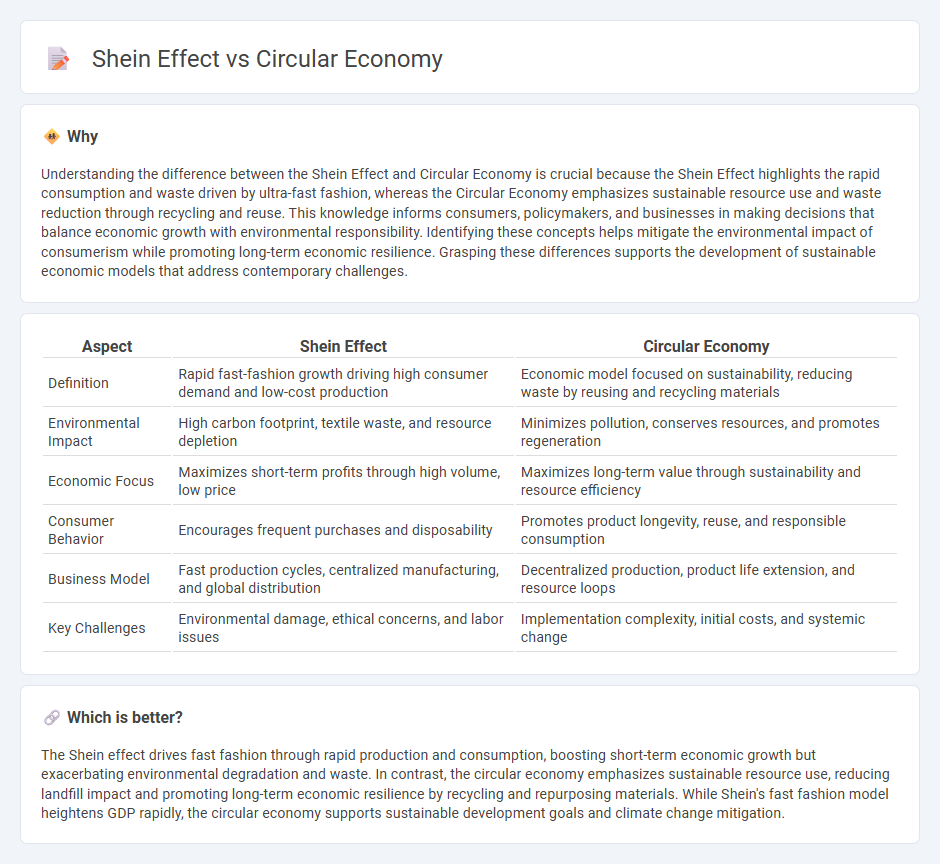
Shein's fast fashion model drives massive consumer demand and rapid product turnover, challenging traditional sustainability efforts within the apparel industry. The circular economy emphasizes resource efficiency, product life extension, and waste reduction through recycling and reuse, countering the environmental impact of rapid consumption patterns. Explore the nuanced economic implications and sustainability trade-offs between Shein's growth and circular economy principles.
Why it is important
Understanding the difference between the Shein Effect and Circular Economy is crucial because the Shein Effect highlights the rapid consumption and waste driven by ultra-fast fashion, whereas the Circular Economy emphasizes sustainable resource use and waste reduction through recycling and reuse. This knowledge informs consumers, policymakers, and businesses in making decisions that balance economic growth with environmental responsibility. Identifying these concepts helps mitigate the environmental impact of consumerism while promoting long-term economic resilience. Grasping these differences supports the development of sustainable economic models that address contemporary challenges.
Comparison Table
| Aspect | Shein Effect | Circular Economy |
|---|---|---|
| Definition | Rapid fast-fashion growth driving high consumer demand and low-cost production | Economic model focused on sustainability, reducing waste by reusing and recycling materials |
| Environmental Impact | High carbon footprint, textile waste, and resource depletion | Minimizes pollution, conserves resources, and promotes regeneration |
| Economic Focus | Maximizes short-term profits through high volume, low price | Maximizes long-term value through sustainability and resource efficiency |
| Consumer Behavior | Encourages frequent purchases and disposability | Promotes product longevity, reuse, and responsible consumption |
| Business Model | Fast production cycles, centralized manufacturing, and global distribution | Decentralized production, product life extension, and resource loops |
| Key Challenges | Environmental damage, ethical concerns, and labor issues | Implementation complexity, initial costs, and systemic change |
Which is better?
The Shein effect drives fast fashion through rapid production and consumption, boosting short-term economic growth but exacerbating environmental degradation and waste. In contrast, the circular economy emphasizes sustainable resource use, reducing landfill impact and promoting long-term economic resilience by recycling and repurposing materials. While Shein's fast fashion model heightens GDP rapidly, the circular economy supports sustainable development goals and climate change mitigation.
Connection
Shein's fast fashion model drives high volumes of low-cost clothing production, increasing textile waste and environmental strain. The circular economy aims to minimize waste through recycling, reuse, and sustainable design, challenging Shein's linear consumption patterns. Integrating circular economy principles could encourage Shein to adopt sustainable practices, reducing resource depletion and promoting long-term economic resilience.
Key Terms
Resource Efficiency
The circular economy emphasizes maximizing resource efficiency by promoting reuse, recycling, and sustainable product design, reducing waste and environmental impact. In contrast, the Shein effect exemplifies fast fashion's resource-intensive model, driving overconsumption and significant textile waste. Discover strategies to enhance resource efficiency and combat the Shein effect's environmental challenges.
Fast Fashion
The circular economy aims to minimize waste and extend the lifecycle of products through recycling, reuse, and sustainable design, contrasting sharply with the Shein effect that promotes rapid consumption and disposal inherent in fast fashion trends. Shein's business model accelerates the production of ultra-affordable clothing, generating significant environmental and social impacts, including increased textile waste and labor exploitation. Explore the implications of these opposing forces on the future of sustainable fashion and consumer behavior.
Waste Generation
The circular economy aims to minimize waste generation by promoting recycling, reuse, and sustainable product design, contrasting sharply with the Shein effect, which drives excessive fast fashion consumption and contributes to massive textile waste globally. Shein's rapid production cycles result in significant environmental strain, with millions of tons of discarded clothing ending up in landfills annually. Explore how shifting consumer habits and innovative policies can reduce waste and foster a more sustainable fashion industry.
Source and External Links
Circular economy - Wikipedia - A circular economy is a model of production and consumption that involves sharing, leasing, reusing, repairing, refurbishing, and recycling materials to extend product lifecycles and reduce waste, aiming to address global issues such as climate change and resource depletion by designing out waste, keeping materials in use, and regenerating natural systems.
What is a circular economy? | Ellen MacArthur Foundation - The circular economy is a regenerative system where materials never become waste, focused on maintaining products and materials through reuse, refurbishment, recycling, and composting, based on principles to eliminate waste, circulate materials at their highest value, and regenerate nature.
What is Circular Economy & How Does It Work? : Complete Guide - Circular economy is an industrial system designed to be restorative, where materials like metals and plastics are continuously reused and recycled, reducing the need for virgin resources and minimizing waste by transforming the linear "take-make-dispose" model into a loop.
 dowidth.com
dowidth.com